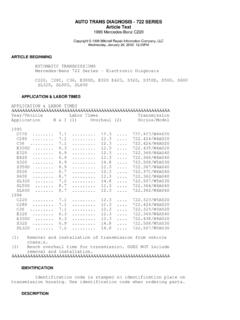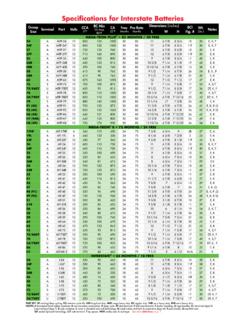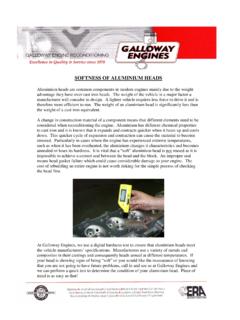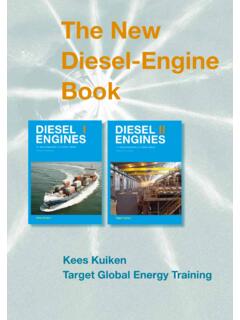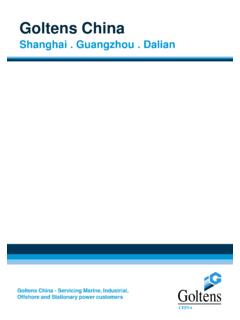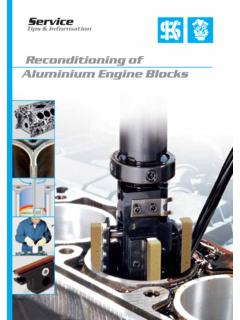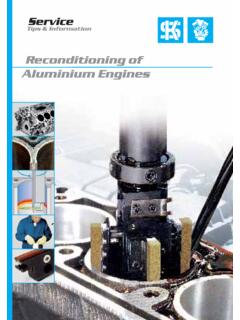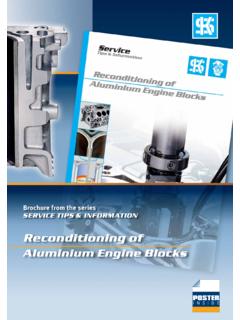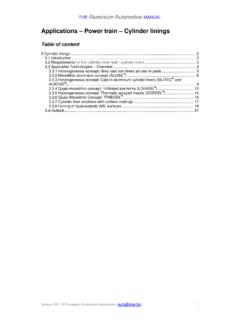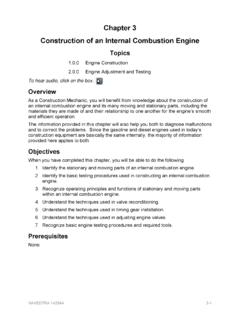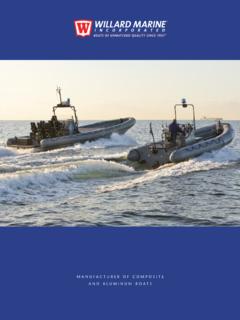Transcription of Reconditioning of Aluminium Engines - W124 Performance
1 Reconditioning ofAluminium EnginesContentsChapter 1: Reasons for using aluminiumcylinder Known brands of aluminiumalloys for cylinder Vehicles/ Engines withaluminium cylinder Design Composite materials forcylinder liners. Aluminium /cast Use of Cr-coated piston KS cylinder liners for AlusilenginesChapter 2: Reconditioning anAlusil cylinder Preparatory machining of thecylinder Installation of the Alusilcylinder Installation with dry Installation with Preheating of the Fitting the cylinder Planing of the cylinder Prehoning, finish honing, Silicon TablesChapter 3: Reconditioning a Lokasil cylinder block based on the example of the Porsche Boxster engineChapter 4: Reconditioning the threads for the cylinder head bolts33333444556666778891416 PageGALNIKAL / Litre 6 Litre 6 cylinders Litre 6 cylinders Litre Litre V8 Motorbike 100 KJAGUARV 8 KOLBENSCHMIDT MAHLEA lusilSilumalGalnikalNikasilChrome cylinderCromalLokasil (KS patent)ALUSIL / Litre before Litre after / LitrePORSCHE928928 S944 BMW750 Litre Litre V8 AUDIV8 LitreV6 LitreLOKASILPORSCHEB oxsterChapter 1.
2 Reasons for using alumin-ium engine blocksIt has always been a challengefor engine designers to make,besides cylinder heads and pis-tons, the entire cylinder blockfrom Aluminium without addition-al cylinder liners or surface rein-forcements. Besides a favour-able running behaviour due toweight reduction, it is especiallythe heat balance which can becontrolled much more easily be-cause the thermal conductivity ofaluminium is about 4 times high-er. The engine warms up morequickly and uniformly. So theweight savings are not limited tothe cylinder block weight but areduction of the cooling watervolume is also possible becauseof the better thermal conductivityand heat radiation of the Known brands of aluminiumalloys for cylinder Vehicles/ Engines with alu-minium cylinder Design detailsAlusil:Alusil:Alusil:Alusil:Alusi l: Alusil base material is expensi-ve and difficult to machine dueto the high silicon content Boring the cylinder block ispossible Oversized pistons are availa-ble Pistons in Alusil blocks arecoated with iron and tinGalnikal:Galnikal:Galnikal:Galnikal:G alnikal: Galnikal base material is chea-per than Alusil and easier tomachine due to its substantial-ly lower silicon content The cylinder bore is nickelcoated Boring the cylinder block is notpossible because of the nickelcoat !
3 Oversized pistons are notavailableChrChrChrChrChromium cylinders:omium cylinders:omium cylinders:omium cylinders:omium cylinders: As Galnikal but: the cylinder bore is chro-mium coatedLokasil / KS patent:Lokasil / KS patent:Lokasil / KS patent:Lokasil / KS patent:Lokasil / KS patent: Lokasil base material costsless than Alusil and is easier toprocess. Preforms, which are specialprefabricated liners from Loka-sil with a high silicon content of20 - 27 %, are cast into the cy-linder bore Oversized pistons are availa-ble Boring of the cylinder block Composite materials for cylinder liners. Alu-minium/cast ironKOLBENSCHMIDTMAHLEA lfin cylinderBiral cylinderAlfin cast into cylinderOuter cylinder wallsurface rough KS cylinder liners for Alusil enginesManufacturer/ engine KS dia-FlangeOutside dia- Inside dia- Lengthmeter (mm) height(mm) meter (mm) meter (mm) (mm)MB Litre before 321 Litre after 189 Litre89 321 Litre89 190 M120 12 418 928S1984-1986 Diameter 97mm89 190 from1985 Diameter 100 mm89 327 toblock heightPORSCHE 94489 327 ,50145,00 BMW M70 12 Cylinder 89 400 raw casting 89 397 190 Use of Cr-coated piston ringsKOLBENSCHMIDTMAHLECr piston ringsAlfin cylinderBiral cylinderpossibleAlusilSilumalpossibleGal nikalNikasilnot possibleChrome cylinderCromalnot possible5 Chapter 2: Reconditioning an Alusil cylinder Preparatory machining ofthe cylinder block (Fig.)
4 1)Tighten the bearing cap applyingthe torque specified by the enginemanufacturer. Next, clamp the cyl-inder block onto the boring ma-chine, align it roughly and thanfasten it. Swivel the cylinder blockand set it to the final machiningposition by fine semi-finished Alusil cylinderliners offered by KS are manufac-tured to a high degree of outside diameter tolerance mm order to achieve an exact bore,the following work sequences arerecommended for preparing thebore to accommodate Alusil liners:Figure 11st stage: Pre-boring with a mate-rial removal of7/10 mm stage: Finish boring with amaterial removal of5/10 mm the flange support is turnedto a diameter B to a depth of C (values see Table 1, page 9).In order to avoid the risk of linerflange cracking, care should betaken to ensure that the supportsurface of the liner flange is ex-actly perpendicular to the diameters for the respectiveengine types can also be foundlisted in Table 1.
5 As dry cylinderliners have extremely thin walls,they may be subject to dimen-sional changes in unstressedcondition, such as oval deforma-tion, but when installed, after theshrinking process, they will againrevert to the cylindrical shape ofthe base bore. Subsequently, thetop edge of the cylinder bore is tobe provided with a chamfer of + mm x 45 . Preheating of the cylin-der block (Fig. 4)A heating oven with appropriatedimensions is ideal for heatingup the cylinder block. The cylin-der block remains in the preheat-ed oven for about 20 - 30 the installation is done with dryice, it is essential to preheat thecylinder block to a temperatureof 160 C. It is not absolutelynecessary to preheat the cylinderblock if the installation work isdone with liquefied , if there is a possibility,we would recommend about 100- 120 temperature difference be-tween cylinder block and liner ofabout 200 C is necessary to en-sure safe 2 Figure 4 Figure Installation of the Alusilcylinder with dry ice(Fig.)
6 2)A relatively simple method is touse CO2 (carbon dioxide) filledinto riser-type pressure principle: when the gasflows out, dry ice is forming dueto the sudden strong dry ice may be collected inan insulated container. This insu-lated container should meet thenecessary demands on insulationand strength. The cylinder linermay be cooled down to about -80 C with the dry with liquidnitrogen (Fig. 3)The cylinder liner is placed inliquid nitrogen and reaches atemperature of -180 C. Liquidnitrogen may be obtained fromthe local gas Fitting the cylinder liner (Fig. 5)Installing the cylinder liner is ab-solutely unproblematic. By cool-ing the cylinder liner, its diameterwill decrease by about mmwhereas by preheating of the cylin-der block, the base bore will be-come enlarged by about mm,so that when fitting the liner, therewill be a clearance of about However, the Alusil cylinderliner should be installed relativelyquickly because this is a cylinderliner of extremely thin walls andaluminium is a very good 5 Figure Planing of the cylinderblock (Fig.
7 6)After aligning, the cylinder blockis planed. The material removalshould be mm in order to en-sure a perfectly plane Prehoning, finish honing,polishing (Fig. 7)Honing should be done using aSunnen honing machine. For thefirst 3 honing phases (prehon-ing, finish honing, polishing),different honing stones are to beapplied. The type of tool used(honing stones, honing oil) andthe machine adjustments are im-portant for efficient machiningand may differ from engine typeto engine type. The respectivevalues can be read from the va-rious tables 7An additional long lifetime can beexpected from an Aluminium cy-linder block reconditioned in thisway ( ).Figure 9 Figure 8 Figure 10 With this machining step, thesilicon crystals in the cylinderblock are exposed, which leadsto a more durable and wear-resi-stant cylinder Silicon lapping (Figs. 8and 9)The fourth and last machiningphase is silicon lapping. In thisprocess, the honing stones arereplaced by felt pads.
8 The cylin-der bore and the felt pads arecoated with silicon polishingpaste. Honing oil is not felt pads and the siliconpaste do not effect a measurablematerial TablesTable 1: Machining dimensions for installing KS Alusil cylinder linersAluminium-Cylinder blockVehicleKS A (mm) Dimension B (mm)Dimension C (mm)MB l before 8/81 89 321 190 l after 8/8189 189 190 l89 321 190 l and l89 190 190 B B B B + + 2: MERCEDES-BENZ Litre engine 2. Series with Sunnen CK- 10/CV- 616 Table 3: MERCEDES-BENZ and litre engine with Sunnen CK- 10/CV- 616 Roughing Finishing Polishing Silicon lapping to to to to Cylinder Std. mmCylinder oversize mm mm mmCylinder length 135 mmHoning head type CK-3000 or CK 2600 dto. dto. length setting 70 mm 70 mm 70 mm 70 mmSetting on machine 140 mm 140 mm 140 mm 120 mmRPM 125 CK / CV 125 CK / CV 125 CK / CV 185 CK / 230 CVSPM 49 CK / 57 CV 49 CK / 57 CV 49 CK / 57 CV 73 CK / 80 CVFeed setting 5 4 3 2 Top stone overstroke 15 mm 15 mm 15 mm 2 mmRoughing stone C 30- J55 Finishing stone C 30-J84 Polishing stone C30- C03- 81 Felt pads C30- F85 Load meter % 30 - 40 30 - 40 20- 30 20- 30 Material removal approx.
9 Mm mm mmapprox. 15 strokesFeed wheel setting 10 lines 10 lines 10 lines60 sec. running timeRoughness Rt. approx. 7-8 my approx. 2 myapprox. - my approx. 1-2 my RougingFinishingPolishingSilicon lapping to to to to Cylinder std. mm Cylinder oversize mm mm Cylinder length 135 mm Honing head type CK-3000 or CK Stroke length setting 70 mm70 mm70 mm70 mm Setting on machine 140 mm140 mm140 mm120 mm RPM 125 CK / CV 125 CK / CV125 CK / CV185 CK / 230 CV SPM 49 CK / 57 CV 49 CK / 57 CV 49 CK / 57 CV 73 CK / 80 CV Feed setting 5432 Top stone overstroke 15 mm15 mm15 mm2 mm Roughing stone C 30- J55 Finishing stoneC 30-J84 Polishing stoneC30- C03- 81 Felt padsC30- F85 Load meter % 30 - 4030 - 4020 - 3020 - 30 Material removal approx. mm approx. 15 strokes Feed wheel setting 10 lines10 lines10 lines 60 sec. running time Roughness Rt.
10 My approx. 2 my - 0,8 my approx. 1-2 my11 Roughing Finishing Polishing Silicon lapping to to to to Table 4: MERCEDES-BENZ and litre engine with Sunnen CK- 10/CV- 616 Table 5: PORSCHE 928 engine with Sunnen CK- 10/CV- 616 Cylinder mmCylinder oversize mmCylinder length 155 mmHoning head type CK-3000 or CK length setting70 mm70 mm70 mm70 mmSetting on machine160 mm160 mm160 mm140 mmRPM 125 CK / CV 125 CK / CV125 CK / CV 185 CK/230 CVSPM 49 CK / 57 CV 49 CK / 57 CV 49 CK / 57 CV 73 CK / 80 CVFeed setting5432 Top stone overstroke15 mm15 mm15 mm2 mmRoughing stoneC 30- J55 Finishing stoneC 30-J84 Polishing stoneC30- C03- 81 Felt padsC30- F85 Load meter %30 - 4030 - 4020- 3020- 30 Material removal mm approx. 15 strokesFeed wheel setting10 lines10 lines10 lines 60 sec.
